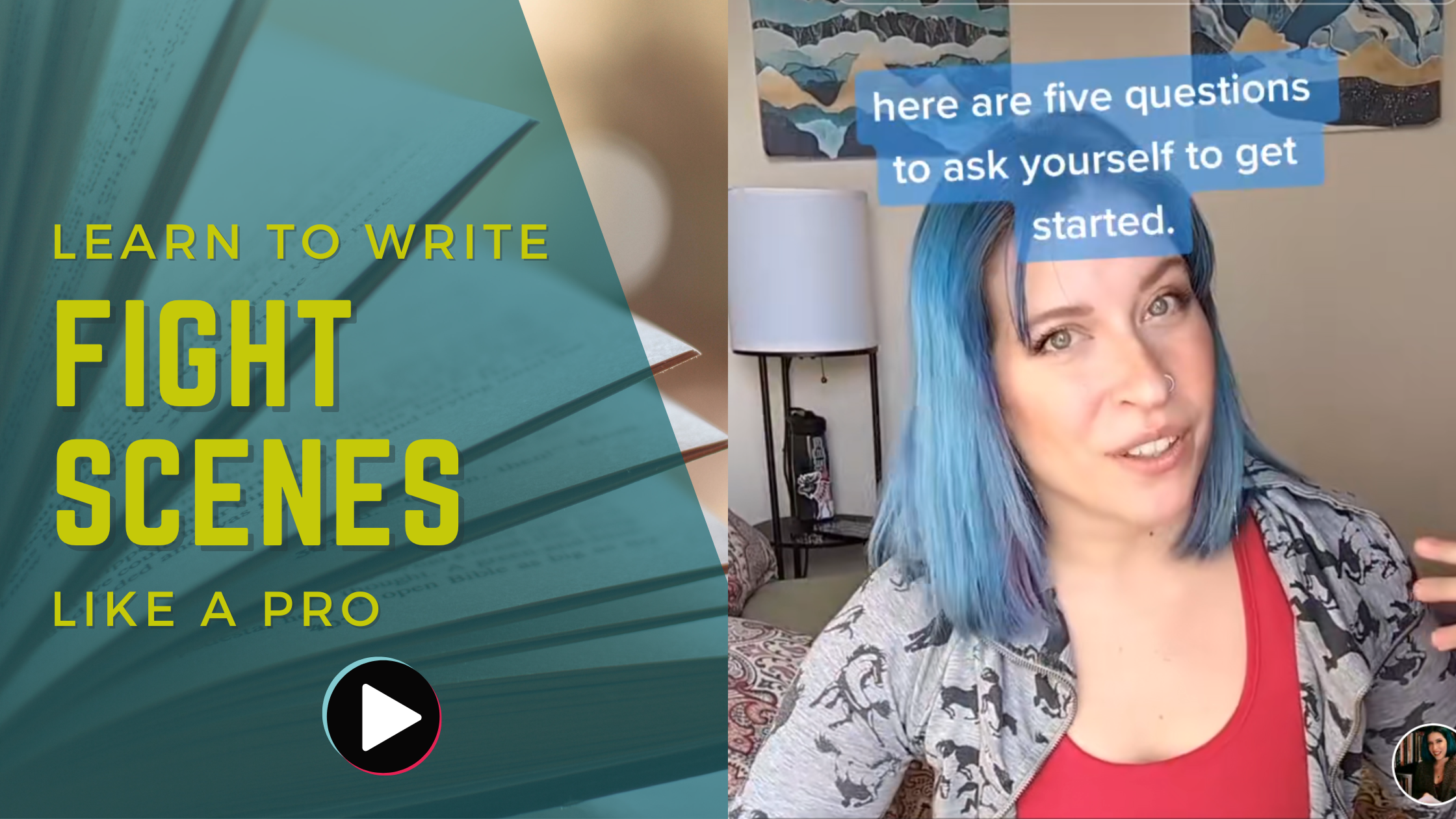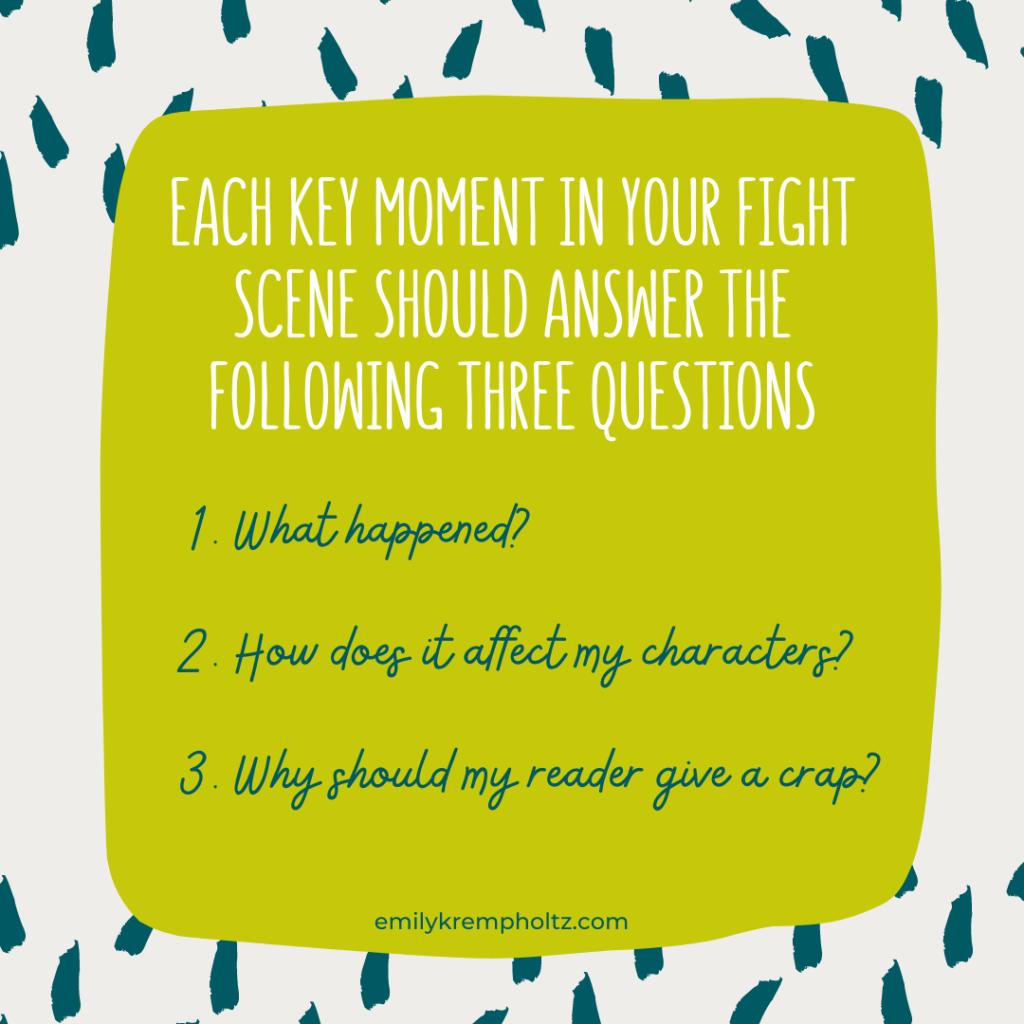Learn to Write Fight Scenes Like a Pro (And Why They’re Much Less About the Action Than You Think!)

Here’s a hot take: Your fight scenes are not nearly as much about the action as you think they are.
Fight scenes aren’t actually action sequences. They’re character sequences, and yes, I will die on this hill.
Think about your favorite fight scenes in any movie or book. They’re not just super-cool choreographed moments (though some of them undoubtedly are—it’s definitely a Venn diagram). They’re moments when your character realizes something about themselves and their abilities. They’re turning points in their internal journey. They’re developmental keystones in your character’s relationships with other characters, in which they realize just how far they’re willing (or unwilling) to go for the things they want. What lines will they cross to reach their goals or protect the ones they love? Will they do something they’ll regret later on?
Remember, your characters are your readers’ connection to your world. To write a fight scene that really impacts your reader, it needs to really impact the character they’ve grown to love and relate to. That’s why the best fights aren’t about violence at all.
Your goal as a writer should be to write your fight scenes like a conversation. A back and forth between two parties who each want different things, and will go to different lengths to get them. Make each side’s actions distinct and unique to their goals, motivations, and values. You can start by asking yourself the following questions:

2. Who is involved? What does each side want? What do they have to gain or lose? How does each side feel about the other? How do their pasts, fears, hopes, and expectations come into play?
3. What are their limits? What, if anything, would make either or both sides back down?
4. How does the fight bring your protagonist closer to or further away from their goals? Are they aware of this effect? Do they plan to do anything about it?
5. How does the fight change things for the plot and characters? How does this sequence act as a turning point in the plot and the character’s development? In what ways can things never return to the way they were before the fight?
Toss a Coin to Your Example
Now look, I can talk theory at you all day long, but I’m a person who learns by example, so an example you shall have.
Anyone else a big fan of The Witcher? I’m not here for arguments about whether the books, video games, or TV show is better (though for full transparency, I’ve read the books and watched the show, but haven’t played the games), because right now, we’re going to focus on this fight scene between Geralt and Renfri from the TV show, using some information from the books as well:
This is one of my favorite choreographed fights from a recent screen adaptation (and I’m obsessed with the season one soundtrack, which makes great music for writing to), but all that aside, what truly makes this scene so impactful is the characters. Geralt and Renfri are mirrors to one another, fearsome warriors who are looked upon by the people around them as monsters. Although she’s only part of his story for a short while, Renfri represents, to Geralt, the choice between holding onto humanity or allowing yourself to become the monster that people think you are. Whether or not you’re familiar with The Witcher and its lore, this scene kicks some serious ass, and in part that’s because it easily answers the questions we just outlined.
- Why is this fight happening? Despite sharing a night together and bonding over their circumstances, Renfri is set on revenge, and is willing to kill a lot of innocents to get to her target, Stregobor the mage, even after she promised Geralt she would leave and never come back. She went back on her word and returned to the town of Blaviken, and now Geralt has to stop her.
- Who is involved? Geralt, our protagonist, is fighting Renfri, a princess turned outlaw (who is based on a grim version of Snow White, as opposed to a Grimm version)—and he really doesn’t want to. Despite Stregobor telling him that killing Renfri would be “the lesser evil,” he cares about her and relates deeply to her struggle, because people think he’s a monster too. That said, he can’t let her slaughter innocent people.
- What are their limits? Renfri has proven to Geralt (and to the audience) that there’s nothing more important to her than her revenge, and she’ll strike down anyone who gets between her and Stregobor. Geralt, on the other hand, is looking for literally any excuse not to kill Renfri. Even when the fight begins, his moves are more defensive, trying to stop her rather than hurt her, even though she shows no such restraint.
- How does the fight bring the protagonist closer to or further from their goals? Geralt’s motivation throughout his storyline is to find connection, and his internal driving goal is to find a family of his own. Killing Renfri technically takes him further from that goal, but since it occurs so early in his plot line it also serves as a catalyst for him, propelling his actions throughout his future adventures.
- How does the fight change things for the plot and characters moving forward? In the TV show, Geralt has Renfri’s brooch attached to his sword hilt in later episodes, and Henry Cavill, who played Geralt, spoke about its meaning: “The addition of Renfri’s brooch on the hilt signifies Geralt’s reinforcement of his beliefs that he shouldn’t get involved in the affairs of men, because they always lead to his own personal pain. And Renfri’s brooch, every time he draws his sword, reminds him that despite how he may be trying to achieve good, evil may be around the corner, regardless.” No matter how you look at it, Renfri’s death sticks with Geralt. She becomes a symbol of the way we force people into roles that may or may not speak to their true potential, and how easy it is to succumb to those expectations, especially when they are monstrous.
The next time you’re tackling a fight scene, stop and ask yourself these questions. See what you come up with. See what kind of depth you can add to your scene.
Going through this exercise with the fight scenes in your book, as well as some fight scenes from other stories, will help you see that the best ones really do put the focus on the character. Fight scenes that fall flat almost always spend too much effort focusing on what happens rather than why it’s happening, and that’s what we’re going to work on next, because that what is still incredibly important, but especially do when you do it right.
Unlocking Your Key Moments
Start finding the why to your fight scenes by determining exactly what key moments happen within the fight. A good fight scene should have its own mini narrative arc. The characters should enter that scene with goals, motivations, and of course, conflicts, and the tension should increase until it climaxes and resolves—for better or worse. Aaaaand in order to do this in a way that makes your reader actually give a crap, you need to focus on—any guesses?—your characters!
Ask yourself what absolutely has to happen in this fight scene by using question number one from the previous section. What led these people to this point, and what inciting incident causes the tension to boil over? From there, plot out what happens, from the circumstances to the turning points to the resolution. Is the attack a surprise ambush? Does the protagonist’s best friend die? Is a new power unveiled that changes the course of the story? Who wins, and who loses?
Now, connect each of those key moments back to your characters. Basically, ask yourself these three questions for each one:
- What happens?
- How does it affect my characters?
- Why should my reader give a crap?

If you’re having trouble answering, that’s totally okay! It just might be a sign you need to do some more work on your fight scene from the character perspective above.
Throwing a Wrench into the Fight
A big part of this part of the process is deciding not just what happens, but what goes wrong. Think about your characters’ expectations and plans. In what ways does the fight go differently than expected? What surprises happen along the way?
A fight scene where a plan is executed flawlessly is B-O-R-I-N-G—boring!—because it keeps the tension flat and doesn’t require the characters to make any game-time decisions that test their personal development, their commitment to their goals, or their relationships with the other characters.
Throwing in a surprise will almost always make your reader more invested in your scene, and force you to explore your characters at a deeper level. (And let’s be real, that’s what all of this is all about in the end!)
Writing Style & Fighting Style
We’ve established your why and your what, so now it’s time to tackle the how. How do you want your reader to feel? Do you want them to feel emotionally involved and terrified that something’s going to happen to their favorite character? Or do you want them to view the fight from a distance, seeing only necessary details so you can give more information later for greater effect? Are you trying to show us how skilled and capable a character is, so they can learn they’re ready for what lies ahead? (Or that they’re too cocky and that might be their downfall?) Or are you using the fight to show how scared and unprepared a character is, so they’re motivated to improve? Each of these decisions should factor into the way you’re writing the scene.
I’m talking craft here, my friend.
How are you writing your fight? What’s your writing style like? The way you put your words together will have an effect on the reader, and the following tips will help you write a fight scene that keeps the tension high and your reader’s interest engaged.
- As a general rule, stay in the moment, without long soliloquies about the POV character’s memories. Grab the reader’s attention and play with their emotions (a lot of that can come from toying with their connection to the characters in the scene!).
- Whose perspective is the fight told from? Focus. On. That. Character. Let us be part of the confusion and chaos and high flying emotions of a fight from their eyes.
- Use short, choppy sentences and frequent paragraph breaks to keep the tension high and the pacing fast.
- Stay active! No passive voice. “His arm was sliced by the sword” doesn’t keep the focus on the character, but “He winced at the sting of the blade as it sunk into his arm” makes us part of his action and the resulting pain.
A Word of Caution
Now, using these craft tips is going to help, I promise, but, and this is a big butt (and I cannot lie), what you want to be careful about is not devolving too much into using stage directions.
Stage directions in books are when a writer lists out every visible action a character makes without taking time to assign meaning to them. Here’s a quick example:
She stood from the chair and walked through the doorway into the kitchen. Turning to the left, she put her plate in the sink and looked out the window with a sigh. The sky outside was cloudy, and rain began to fall as she turned on the faucet and began washing her dishes.
Yikes, right?
Stage directions suck because they drive a wedge between your reader and the story. By dictating exactly what the characters are doing at any given moment without letting us into those characters’ heads and telling us why those actions are important, you’re removing the reader’s agency in their own imagination, and the second you do that, you downgrade their interest. When it comes to fight scenes, sex scenes, or any kind of action-heavy sequence, know what the important moments are, and let the reader connect the dots.
I don’t care how much research you’ve done into the intricacies of swordplay. The second you start spelling out each blow and parry in terms of how the character moves their body and what direction each assault is coming from, you’ve lost. Straight up blow-by-blow violence without deeper meaning for the character is boring. Want another example? Here you go:
The two swordsmen faced each other, standing about six feet apart. One pulled his rapier from his belt, brandishing it in front of him with a flourish. His enemy drew her sword too, and the two of them began to fight. The first swordsman took a step forward and stabbed with his weapon, but the second swordsman dodged the blow, spinning to the side and attacking from the left. The first swordsman was forced to retreat by taking a quick step back.
Honestly, I hated writing that as much as you probably hated reading it. It’s boring! It’s bland! I don’t give a shit about how they’re standing or what each strike is like—unless there is a reason for me to care.
And what do you think that reason might be?
Yep, once again, it’s the characters!
Even the most technical descriptions of a fight can be made much more fascinating by some character details. Give me the sweat rolling down someone’s neck, or the cry of a fallen friend. Give me that fleeting moment of regret when a character thinks they’re about to die without ever having told their true love how they feel, or the rush of anger as an assumed friend reveals their betrayal. Throw in a little bit of dialogue, and some sensory details. Pepper it into the action so none of it feels overwhelming, and the pace moves just as quickly as it did before, but with the benefit of being about the characters now, not the action.
The truth is, most of us focus way too much on the setup. You can lay out your scene all you want, but the fact of the matter is that most readers are going to create the action a little differently in their head, no matter how you write it. Sure, major details like a cliff or a staircase or a fire blazing behind them will remain the same, but the exact positions, setup, and circumstances are often best left to the reader’s imagination. Remember, your audience is there because they love making shit up in their heads! That’s half the joy of reading!
Set the stage and let your reader direct the choreography. Trust in your reader’s imagination.
They’ve got this.
And so do you.

